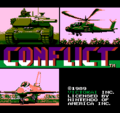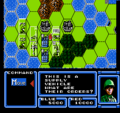No edit summary |
m (cleanup) |
||
| (4 intermediate revisions by 3 users not shown) | |||
| Line 1: | Line 1: | ||
{{Header Nav|game=Conflict}} | |||
{{Header Nav|game=Conflict | {{Game | ||
{{ | |completion=0 | ||
|image=Conflict NES box.jpg | |||
|title=Conflict | |title=Conflict | ||
|developer=[[Vic Tokai]] | |developer=[[Vic Tokai]] | ||
|publisher=[[Vic Tokai]] | |publisher=[[Vic Tokai]] | ||
| | |year=1989 | ||
|systems={{syslist|nes}} | |||
|genre=[[Strategy]] | |genre=[[Strategy]] | ||
| | |modes=[[Single player]] | ||
|followed by=[[Super Conflict: The Mideast]] | |followed by=[[Super Conflict: The Mideast]] | ||
|series=Conflict | |series=Conflict | ||
}} | }} | ||
{{series | {{game disambig||the series of [[action]] '''Conflict''' games|{{c|Conflict (action)}}}} | ||
{{ | {{nihongo|'''Conflict'''|コンフリクト}} is a hex-based war game developed and published by [[Vic Tokai]] exclusively for the [[NES]], first in Japan in [[1989]], and later in North America in [[1990]]. It shares some similarities with the Parker Brothers board game of the same name, especially in terms of how certain units have advantages and disadvantages that the player must learn to exploit. A sequel was released for the [[SNES]] entitled [[Super Conflict]]. | ||
<gallery> | |||
File:Conflict FC box.jpg|Famicom box art | |||
File:Conflict NES title.png|Title screen | |||
File:Conflict NES screen.png|Game screen | |||
</gallery> | |||
The | ==Gameplay== | ||
Players take the role of a commander who must lead their forces to victory. The player can earn fame points by occupying cities and airports and destroying units of the opponent's army; fame points are lost by losing units of one's army in battle or retreating from battles. The goal of each of the 16 scenarios is to destroy the enemy's flag tank. The first player controls the blue (Western Bloc) forces while the computer (or second player) controls red (Eastern Bloc) troops. | |||
Each player starts with two factories, at least one of which specializes in air combat units and at least one of which specializes in ground warfare units. On each turn, the player can, if they still have a factory that has not been destroyed, produce one military unit. The more fame points the player has, the more powerful units they can produce (e.g. tanks instead of infantry). The computer always starts with more fame points than the player; since this state of affairs tends to produce an increasingly overwhelming materiel advantage if left unaddressed, the goal of depleting the computer's fame points, usually by destroying powerful red Army units, tends to be a high priority at the beginning of the game. | |||
The hexagons can be plains, woods, mountains, barren terrain, shoals, seas, bridges, airports, towns, or factories. The terrain in each hexagon has an effect on maneuverability and the extent to which forces can take evasive action. Units can be repaired, refueled, and rearmed at cities or airports, depending on whether the unit is a ground or air unit. | |||
{{ToC}} | |||
{{Conflict}} | |||
[[Category: | [[Category:Vic Tokai]] | ||
[[Category:Strategy]] | [[Category:Strategy]] | ||
[[Category:Single player]] | [[Category:Single player]] | ||
Latest revision as of 01:43, 20 March 2023
This is the first game in the Conflict series. For other games in the series see the Conflict category.

| Conflict | |
|---|---|
| Developer(s) | Vic Tokai |
| Publisher(s) | Vic Tokai |
| Year released | 1989 |
| System(s) | NES |
| Followed by | Super Conflict: The Mideast |
| Series | Conflict |
| Genre(s) | Strategy |
|---|---|
| Modes | Single player |
- For the series of action Conflict games, see Conflict (action).
Conflict (コンフリクト?) is a hex-based war game developed and published by Vic Tokai exclusively for the NES, first in Japan in 1989, and later in North America in 1990. It shares some similarities with the Parker Brothers board game of the same name, especially in terms of how certain units have advantages and disadvantages that the player must learn to exploit. A sequel was released for the SNES entitled Super Conflict.
-
Famicom box art
-
Title screen
-
Game screen
Gameplay[edit]
Players take the role of a commander who must lead their forces to victory. The player can earn fame points by occupying cities and airports and destroying units of the opponent's army; fame points are lost by losing units of one's army in battle or retreating from battles. The goal of each of the 16 scenarios is to destroy the enemy's flag tank. The first player controls the blue (Western Bloc) forces while the computer (or second player) controls red (Eastern Bloc) troops.
Each player starts with two factories, at least one of which specializes in air combat units and at least one of which specializes in ground warfare units. On each turn, the player can, if they still have a factory that has not been destroyed, produce one military unit. The more fame points the player has, the more powerful units they can produce (e.g. tanks instead of infantry). The computer always starts with more fame points than the player; since this state of affairs tends to produce an increasingly overwhelming materiel advantage if left unaddressed, the goal of depleting the computer's fame points, usually by destroying powerful red Army units, tends to be a high priority at the beginning of the game.
The hexagons can be plains, woods, mountains, barren terrain, shoals, seas, bridges, airports, towns, or factories. The terrain in each hexagon has an effect on maneuverability and the extent to which forces can take evasive action. Units can be repaired, refueled, and rearmed at cities or airports, depending on whether the unit is a ground or air unit.


